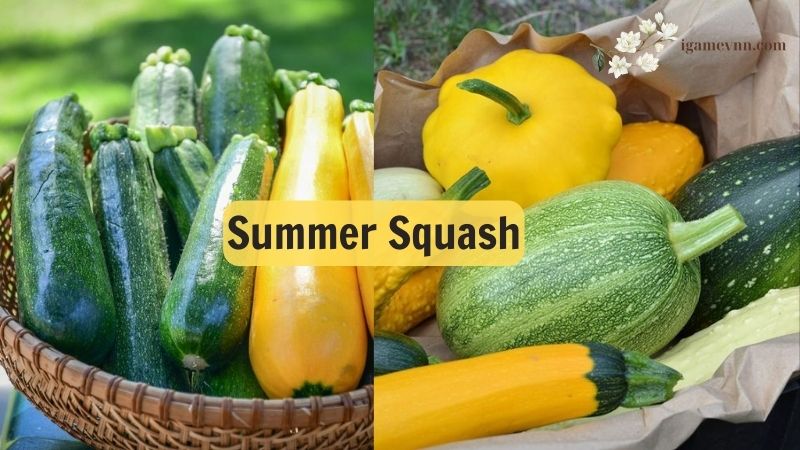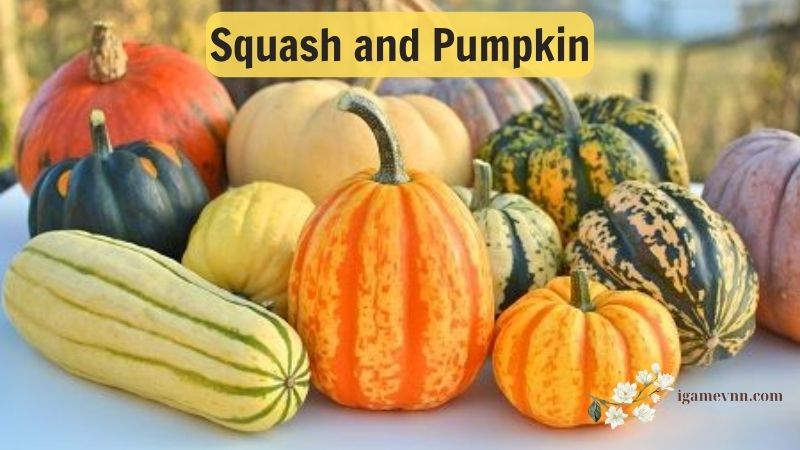Squash and pumpkin, both members of the Cucurbitaceae family, are staples in kitchens and gardens around the world. These versatile vegetables come in a variety of shapes, sizes, and flavors, offering endless culinary possibilities. This article from Igamevnn delves into the diverse world of squash and pumpkin, exploring their types, nutritional benefits, culinary uses, growing conditions, and harvesting tips.
Table of Contents
ToggleTypes of Squash and Pumpkin
Squash is typically categorized into two main types: summer squash and winter squash.
Summer Squash:
- Examples: Zucchini, yellow squash, and pattypan squash.
- Characteristics: Summer squash have thin, edible skins and tender flesh. They are harvested while still immature, which is why they have a shorter shelf life compared to winter squash.
- Uses: Their delicate texture makes them perfect for salads, sautés, grilling, and stir-fries.

Winter Squash:
- Examples: Butternut squash, acorn squash, spaghetti squash, and Hubbard squash.
- Characteristics: Winter squash have thick, hard rinds and firmer flesh. They are harvested when mature, giving them a longer shelf life. Their hard skin requires peeling or baking to soften before eating.
- Uses: These squashes are ideal for baking, roasting, and adding to soups and stews, providing a hearty and comforting meal during colder months.
Pumpkin:
Although technically a type of winter squash, pumpkins are often treated as a distinct category due to their unique characteristics and cultural significance.
- Characteristics: Pumpkins are usually round with smooth, slightly ribbed skin that can range in color from orange to yellow, green, or even white. They are known for their sweet and earthy flavor.
- Uses: Commonly used in baking (e.g., pumpkin pie), soups, and savory dishes. Pumpkin seeds, known as pepitas, are also popular when roasted and eaten as snacks.

Nutritional Benefits of Squash and Pumpkin
Squash and pumpkin are not only delicious but also packed with nutrients. They are rich in vitamins A and C, potassium, and fiber, making them excellent additions to a healthy diet.
Vitamins:
- Vitamin A: Essential for good vision, a healthy immune system, and cell growth. The vibrant orange color of many squashes and pumpkins is due to their high beta-carotene content, which the body converts into vitamin A.
- Vitamin C: Important for the growth and repair of tissues, vitamin C also helps the body absorb iron from plant-based foods and boosts the immune system.
Minerals:
- Potassium: Helps maintain proper muscle function and fluid balance in the body.
- Magnesium: Important for muscle and nerve function, regulating blood pressure, and supporting the immune system.
Fiber: Both squash and pumpkin are excellent sources of dietary fiber, which aids in digestion and helps maintain a healthy weight by keeping you feeling full longer.
Antioxidants: The high antioxidant content in squash and pumpkin can help reduce inflammation and protect against chronic diseases.
Culinary Uses of Squash and Pumpkin
The culinary versatility of squash and pumpkin is impressive. They can be prepared in a multitude of ways, each bringing out different flavors and textures.
Summer Squash:
- Grilled: Slice zucchini or yellow squash and grill them with a bit of olive oil and seasoning for a quick and healthy side dish.
- Sautéed: Cook thinly sliced summer squash in a pan with garlic, onions, and herbs for a simple yet delicious meal.
- Salads: Raw summer squash can be spiralized or thinly sliced and added to salads for a crunchy, fresh component.
Winter Squash:
- Roasted: Cut winter squash into cubes or slices, toss with olive oil and seasonings, and roast until tender and caramelized. This method brings out the natural sweetness and creates a rich, savory flavor.
- Soups: Puree roasted butternut or acorn squash with broth, cream, and spices for a warming and comforting soup.
- Stuffed: Fill halved winter squash with grains, vegetables, and proteins for a hearty and nutritious meal.

Pumpkin:
- Baking: Pumpkin puree is a common ingredient in pies, breads, muffins, and cakes. Its sweet and earthy flavor pairs well with spices like cinnamon, nutmeg, and cloves.
- Savory Dishes: Pumpkin can be used in savory dishes such as risottos, pastas, and curries. Its creamy texture adds a rich, velvety element to these meals.
- Seeds: Pumpkin seeds can be roasted with various seasonings for a crunchy and nutritious snack. They are also a great addition to salads, granolas, and trail mixes.
Growing Squash and Pumpkin
Growing squash and pumpkin in your garden can be a rewarding experience. They thrive in warm weather, well-drained soil, and plenty of sunlight.
Planting:
- Timing: Squash and pumpkin should be planted after the last frost when the soil has warmed. They require a long growing season, typically between 75 to 120 days.
- Spacing: These plants need plenty of space to spread out. Plant seeds or seedlings in hills or mounds, spacing them at least 3-5 feet apart to accommodate their sprawling vines.
Care:
- Watering: Both squash and pumpkin need consistent watering, especially during dry spells. Ensure the soil is moist but not waterlogged.
- Fertilizing: These plants are heavy feeders. Incorporate compost or a balanced fertilizer into the soil at planting and apply additional fertilizer as they grow.
- Pest Control: Common pests include squash bugs, cucumber beetles, and vine borers. Use row covers, hand-pick pests, and apply organic insecticides if necessary.
Harvesting Squash and Pumpkin
Harvesting squash and pumpkin at the right time is crucial for the best flavor and texture.
Summer Squash:
- Timing: Harvest summer squash when they are young and tender, typically when they reach 6-8 inches in length. Regular harvesting encourages the plant to produce more fruit.
- Method: Use a sharp knife or pruning shears to cut the squash from the vine, being careful not to damage the plant.
Winter Squash and Pumpkin:
- Timing: Harvest when the skin is hard and cannot be easily pierced with a fingernail. The stem should be dry and beginning to shrivel.
- Method: Cut the fruit from the vine, leaving a few inches of stem attached. This helps prolong storage life.
- Storage: Store winter squash and pumpkins in a cool, dry place. They can last several months if kept properly.
Conclusion
Squash and pumpkin are versatile, nutritious, and easy to grow, making them valuable additions to any diet and garden. Whether you enjoy them grilled, roasted, baked, or pureed, there are countless ways to incorporate these delicious vegetables into your meals. By understanding the different types, nutritional benefits, and growing conditions, you can make the most of squash and pumpkin in your culinary adventures. So, embrace the world of squash and pumpkin, and let these vibrant, flavorful vegetables inspire your next dish.

